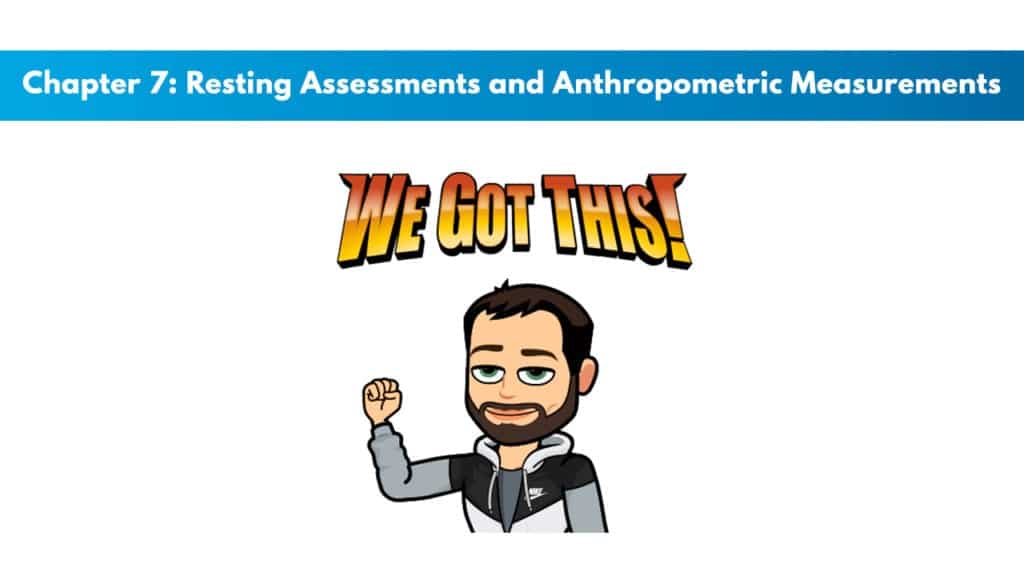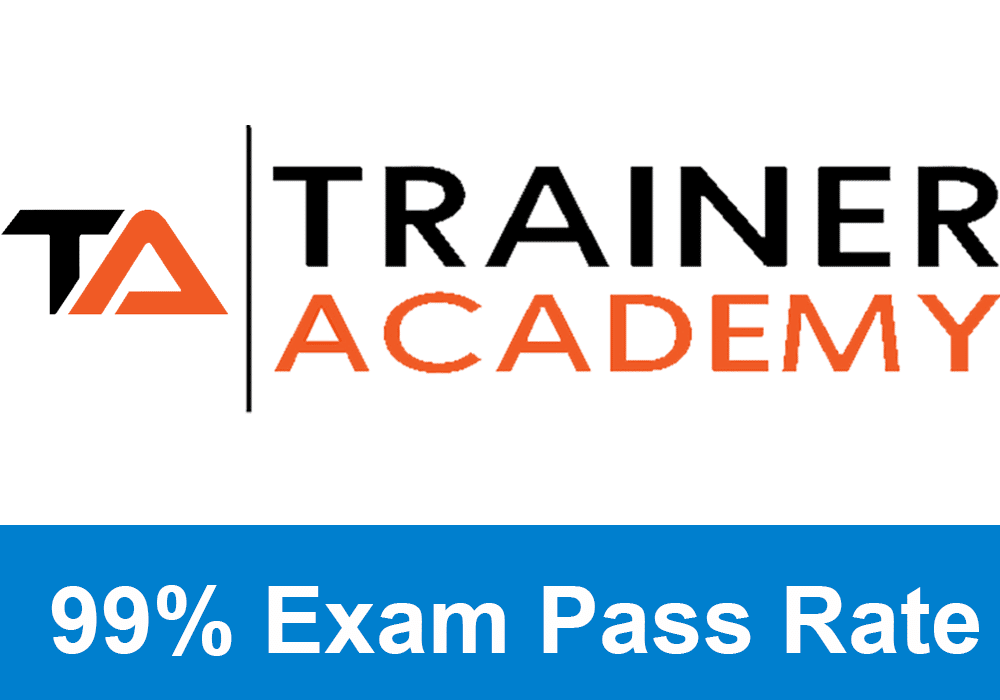
If you have not yet signed up for the ACE CPT certification, receive a big discount here.
Get your copy of the ACE CPT exam cheat sheet.
It helps immensely in your ability to study for the ACE test. This PDF printable one-page sheet gives you a breakdown of the skills and knowledge candidates need to pass the exam.
My PTP students report cutting their ACE study time and effort in half with Trainer Academy.
Benefit from the Exam Pass Guarantee and Retake Fee Guarantee. Plus, take advantage of my current discount code PTPJULY for 35% off the MVP Program (Ends July 17th, 2025).
Try it out for free here to see if it’s right for you, or read my detailed review for further insights.
Chapter Goals:
- Be able to explain the need for the right sequencing of assessments that are done at rest.
- Know the procedures for measuring heart rate and blood pressure at rest and the conditions under which they should be measured.
- Find the various methods for estimating the body composition and explain the advantages and disadvantages of each.
- Explain the practical reasons for using BMI and the limitations that exist for estimating overweight and obesity.
- Find the anatomical landmarks and the assessment protocols that are associated with various circumference measures.
Introduction
Baseline assessments are done to do four things.
One is to identify areas of risk regarding health and injuries for possible referral to the right healthcare professional.
Two is to collect baseline data that can be used to develop a personalized cardio and muscular training program and allow for comparison of subsequent evaluations.
Three is to educate clients about their present physical condition and health risks by comparing their results to normative data for age and sex.
Four is to motivate clients by helping the establish realistic goals.
Sequencing Assessments
There is a debate over the timing and the specific modalities that are chosen in the initial assessment.
Some assessments, but possibly not all of them, should be done early on, possibly even in the first meetings between the client and trainer.
Chapters 8 and 10 will detail the physiological assessments in more detail, but this chapter will focus on the assessments outside of those. These are just as important.
The trainers should have a solid understanding of the needs of the client and then they will determine the assessments to be done and the timing for them.
The assessments that merit consideration will generally be these:
Exclusive PTP CPT Offers |
||
|---|---|---|
Most Popular Cert | Best Online NCCA Cert | Best Study Materials |
Gold Standard Cert | A Good Option | Best CPT for you?  |
- Resting vital signs like the resting heart rate, blood pressure, height, and weight.
- Static posture and movement assessments.
- Joint flexibility and muscle length tests.
- The function of the core and balance.
- Cardiorespiratory fitness levels.
- Body composition and anthropometry.
- Muscular fitness, endurance, and strength.
- Skill related parameters.
There is a table for the recommended order for all of these tests that trainers should follow, and it stays relevant to the needs, preferences, and the desire of the clients.
The physiological influences on an assessment should be well considered when establishing the sequence and timelines for the client. Resting tests like blood pressure should never be taken right after some form of physical exertion in other tests, as this will skew the results.
It is important that personal trainers embody the highest levels of professionalism by being fully prepared when they are conducting assessments and integrating these things:
- Distributing the instructions before the assessments so that they are clearly outlined with the client’s responsibilities.
- Obtaining a signed consent form from the client.
- Organizing all of the needed forms, documentation, datasheets, and tables for assessments.
- Communicating and demonstrating the skills, clearly explaining the assessments and sequencing for them, and instructing them calmly and confidently.
- Calibrating and ensuring the proper working condition for all exercise equipment.
- Controlling the environment and ensuring the temperature and humidity levels are ideal.
Cardiovascular Assessment at Rest
Heart Rate
The pulse rate can be measured at any point on the body where an artery is close to the surface. Here are the common sites for this:
- Radial artery
- Carotid artery
It is also possible to check the heart rate using a stethoscope over the heart.
We record the heart rate in the measure of beats per minute. This can be counted in one minute or seconds and then multiplied to reach the 60 second mark.
Heart rate is a valid indicator of the work intensity or the stress on the body when doing exercise. But also, it is important to keep in mind that the level of accuracy and work stress can vary due to the many differences we see from person to person.
We see someone as having a slow heart rate when at rest they have a heart rate of fewer than 60 beats per minute.
A normal resting heart rate is seen as having one from 60 – 100 beats per minute.
A fast resting heart rate is seen as having one that is higher than 100 beats per minute.
Knowing the resting heart rate of your client will provide insight into their potential for developing things like overtraining syndrome, as any elevation higher than 5 bpm over the normal RHR can indicate this.
Certain drugs and medications will play a role in the resting and active heart rates, so this is another area where the knowledge of substances is needed.
The body’s position will affect the reading we get for the client’s heart rate.
Digestion will increase the resting heart rate.
Environmental factors and stresses will affect the resting heart rate also.
A true resting heart rate should be taken when the client has just gotten out of bed in the morning. This is not really possible for the trainer to take, so it will never be this fully true measure.
Blood Pressure
This is defined as the outward force that is put on the blood vessels by the blood. This will be recorded in the form of two numbers. Systolic and diastolic.
The systolic blood pressure is going to be the high number in the readings, and it is seen as the pressure that is created when the heart pumps blood into circulation via the ventricular contractions.
Exclusive PTP CPT Offers |
||
|---|---|---|
Most Popular Cert | Best Online NCCA Cert | Best Study Materials |
Gold Standard Cert | A Good Option | Best CPT for you?  |
The diastolic blood pressure is the bottom number in the readings, which is the pressure exerted on the artery walls when they are in the resting phase and not actively contracting.
Blood pressure readings are taken by listening to the Korotkoff sounds, which are the sounds made from the vibrations as blood is moving through the walls of the vessel. These sounds are present when there is some degree of deformation present in the walls.
These are the categories of blood pressure readings for adults:
- Normal systolic is seen as less than 120 and diastolic is less than 80.
- Elevated systolic is 120 – 129, and diastolic is less than 80 still.
- Stage one hypertension for the systolic number is 130 – 139, and diastolic is 80 – 89.
- Stage two hypertension is greater than or equal to 140 for systolic and for diastolic it is 90 or greater.
Anthropometric Measurements and Body Composition
Body composition looks at the relative proportions of the body’s lean tissues and fat tissues.
Lean body mass comprises muscles, connective tissues, bones, blood, nervous tissue, skin, and organs. These tissues are considered to be metabolically active and allow the body to work.
We require some body fat for insulation and regulating heat, producing hormones, cushioning the vital organs, and maintaining some cellular body functions. We call this body fat the essential body fat.
Many people can lose weight or body fat easily in the short term, but they are not as successful in the long term. Regularly exercising is a key part of not only effective weight loss but also the maintenance of a healthy weight.
The major importance will be placed on differentiating between overweight and overfat.
Overweight is the excess levels of body weight in general compared to the person’s height. Since we only factor in the height and weight, some of this could actually be fat mass or lean tissue. Overfat is what we use to indicate that a person has excess body fat levels.
Bioelectrical impedance is the use of electrical signals passing through the fat, lean mass, and water in the body to calculate body fat and muscle levels. This is available in many settings, but the lab settings are more accurate.
Air displacement plethysmography is also known as the bod pod. This is a very costly device where you sit in the machine and the air displacement is measured to determine the body fat levels.
Dual energy x-ray absorptiometry is found in clinical settings more often. It uses x-rays to read the mass of the soft tissues and bones and give back calculations on the body’s composition.
Skinfold measurements are among the more popular methods to estimate the body fat levels of the body. Here we use a skinfold caliper to measure the subcutaneous fat tissues at specific sites where certain populations primarily hold their fat. This is considered one of the more practical tools for body composition in the fitness settings we usually see.
These skinfold sites are chosen because they are where each gender holds the highest percentage of their body fat.
For male clients, we use these sites:
- The Chest: A diagonal skinfold is taken midway between the anterior axillary line and the nipple.
- The Thigh: A vertical skinfold is taken on the anterior midline of the thigh between the inguinal crease at the hip and the proximal border of the patella.
- Abdominal: A vertical skinfold is taken 2 centimeters to the right of the umbilicus.
For female clients, we use these sites:
- The triceps: A vertical skinfold on the posterior midline of the upper arm taken halfway between the acromion and the olecranon processes.
- The thigh: A vertical skinfold is taken on the anterior midline of the thigh between the inguinal crease at the hip and the proximal border of the patella.
- The suprailium: A diagonal fold following the natural line of the iliac crest taken immediately superior to the crest of the ilium and in line with the anterior axillary line.
We then use the measurements we get in the skinfold measures and plug them into an equation based on the gender and the sites that are used to measure. These equations work to utilize the right sites based on where specific people hold their body fat.
The main problem with skinfold measuring is that it requires a good amount of experience from the operator. Once the person has mastered the technique, it is a pretty accurate testing procedure.
Magnetic Resonance imaging, also called MRI, uses magnetic fields to assess how much fat someone has and where this fat is deposited. These are mostly used within clinical settings, and it is not very practical to use them for only body fat calculations, but still, it is possible.
Hydrostatic weighing is a method that utilizes water that someone displaces when they are fully submerged, and thereby it will indirectly be used to measure body fat via the measure of body density.
Height, Weight, and Body Mass Index
Height is the vertical distance that is between the soles of the feet and the top of the head. We usually will measure this quickly and easily with a stadiometer.
Weight is the maximal force that is exerted by the person on a scale while they are wearing light clothing and standing erect with weight evenly distributed across the feet. We use many forms of scales for this.
BMI is short for the term body mass index. We calculate this by dividing the weight in kilograms by the height in meters squared. This is one of the simplest calculations that can be done, and due to that, it has its drawbacks.
For the general population, Body mass index is a good tool to see where you stand, but it is not as accurate for those on either extreme, either lean or muscular. When someone has much more muscle, the calculation will return as unhealthy due to the higher weight to height ratio. But, for the general public, it is an ok tool for quick and somewhat good health results.
The BMI classifications:
- Underweight is classified as a BMI that is lower than 18.5.
- Normal is classified by a BMI of 18.5 – 24.9.
- Being overweight is classified as a BMI of 25 – 29.9.
- The next Obesity class is then classified as a BMI of 35 – 39.9.
- The classification of extreme obesity is any BMI 40 and over.
Circumference Measurements
Circumference measurements are very typical measurements that will be good predictors of health problems.
Another good use for these measures would be to see the overall progress of someone’s body as they go through a program. These measures will be taken at the same spot each time, showing how a body part grows or gets smaller, indicating muscle gain or fat loss.
Accuracy is very important with these, to ensure that we are actually seeing changes over time.
Some guidelines to be followed will be things like:
- When taking the body circumference measures, it is important to measure consistently and precisely.
- All measures should be made with a non-elastic, but flexible tape.
- The tape should be snug against the person’s skin without pressing into the subcutaneous layers.
- Personal trainers should rotate through the battery of sites, initially measuring each site once.
- Duplicate measures should be taken at each site to ensure we get the same results.
Some other protocols for these measurements will be with things like:
- Make sure to take these assessments before exercising.
- The personal trainer should ensure they explain the procedure well and are comfortable with the sites.
- Each measure should be done at the precise landmarks.
- Personal trainers should record values on the assessment form and then evaluate and classify the measures using normative data.
- Trainers should discuss the health and fitness concerns related to abnormal readings.
The sites we use will be the abdomen, hip, waist, biceps, and the midthigh.
For every inch of increase in the circumference of the waist, we see the following things:
- Blood pressure is seen to increase by 10 percent.
- Blood cholesterol levels will increase by 8 percent.
- HDL levels decrease by around 15 percent.
- Triglycerides increase by around 18 percent.
- Metabolic syndrome risk increases by 18 percent.
The waist circumference measure classifications for adults are:
- Very low risk is a waist circumference of less than 27.3 inches in females and 31.2 inches for males.
- Low risk will be a waist circumference of 27.3 – 34.7 inches for females and 31.2 – 38.6 inches for the males.
- High risk will be 35.1 – 42.5 inches for females and then 39 – 46.8 inches for men.
- Very high risk will be more than 42.9 inches for females and 46.8 inches for men.
We can also utilize the waist to hip ratio to look at the health of clients and the potential risk for disease.

 Have a question?
Have a question? 



Tyler Read
PTPioneer Editorial Integrity
All content published on PTPioneer is checked and reviewed extensively by our staff of experienced personal trainers, nutrition coaches, and other Fitness Experts. This is to make sure that the content you are reading is fact-checked for accuracy, contains up-to-date information, and is relevant. We only add trustworthy citations that you can find at the bottom of each article. You can read more about our editorial integrity here.